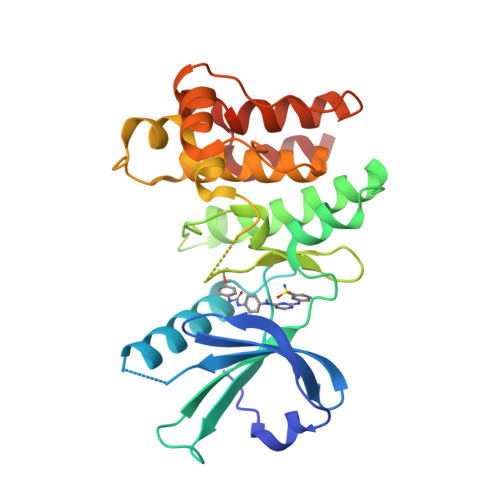GtoPdb is requesting financial support from commercial users. Please see our sustainability page for more information.
mixed lineage kinase domain like pseudokinase
 Target has curated data in GtoImmuPdb
Target has curated data in GtoImmuPdb
Target id: 2106
Nomenclature: mixed lineage kinase domain like pseudokinase
Abbreviated Name: MLKL
Family: TKL-unique family
Contents:
Gene and Protein Information  |
||||||
| Species | TM | AA | Chromosomal Location | Gene Symbol | Gene Name | Reference |
| Human | - | 471 | 16q23.1 | MLKL | mixed lineage kinase domain like pseudokinase | |
| Mouse | - | 472 | 8 E1 | Mlkl | mixed lineage kinase domain-like | |
| Rat | - | 464 | 19q12 | Mlkl | mixed lineage kinase domain like pseudokinase | |
Previous and Unofficial Names  |
| mixed lineage kinase domain-like | mixed lineage kinase domain like |
Database Links  |
|
| Alphafold | Q8NB16 (Hs), Q9D2Y4 (Mm) |
| ChEMBL Target | CHEMBL1938217 (Hs) |
| Ensembl Gene | ENSG00000168404 (Hs), ENSMUSG00000012519 (Mm), ENSRNOG00000042353 (Rn) |
| Entrez Gene | 197259 (Hs), 74568 (Mm), 690743 (Rn) |
| Human Protein Atlas | ENSG00000168404 (Hs) |
| KEGG Gene | hsa:197259 (Hs), mmu:74568 (Mm), rno:690743 (Rn) |
| OMIM | 615153 (Hs) |
| Pharos | Q8NB16 (Hs) |
| RefSeq Nucleotide | NM_152649 (Hs), XM_356104 (Mm), XM_001075467 (Rn) |
| RefSeq Protein | NP_689862 (Hs), NP_083281 (Mm), XP_001075467 (Rn) |
| SynPHARM |
84261 (in complex with MLKL compound 1) 84262 (in complex with MLKL compound 1) |
| UniProtKB | Q8NB16 (Hs), Q9D2Y4 (Mm) |
| Wikipedia | MLKL (Hs) |
Selected 3D Structures  |
|||||||||||||

|
|
||||||||||||
Download all structure-activity data for this target as a CSV file 
| Inhibitors | |||||||||||||||||||||||||||||||||||||||||||||||||||||||||||||||||||||||||||||||||||
| Key to terms and symbols | View all chemical structures | Click column headers to sort | |||||||||||||||||||||||||||||||||||||||||||||||||||||||||||||||||||||||||||||||||
|
|||||||||||||||||||||||||||||||||||||||||||||||||||||||||||||||||||||||||||||||||||
| Other Binding Ligands | |||||||||||||||||||||||||||||||||||||||||||||||||||
| Key to terms and symbols | Click column headers to sort | ||||||||||||||||||||||||||||||||||||||||||||||||||
|
|||||||||||||||||||||||||||||||||||||||||||||||||||
| Immunopharmacology Comments |
| We have included MLKL in the Guide to IMMUNOPHARMACOLOGY because of its essential role in the necroptosis pathway; necroptosis being a regulated type of necrosis, or inflammatory cell death that is associated with tissue damage in a range of proinflammatory diseases, including chronic obstructive pulmonary disease, atherosclerosis, acute colitis, psoriasis and atherosclerosis [4,8-9]. The receptor interacting protein kinases RIPK1 and RIPK3 [6], and pseudokinase MLKL [7] are the core regulators of necroptosis. As such, these 3 proteins are being pursued as molecular targets for the development of drugs that can be used to treat necroptosis-related diseases. Necroptosis can be induced by a variety of mediators, including death receptors [1], interferons, Toll-like receptors and intracellular RNA and DNA sensors (and possibly others). |
| General Comments |
| MLKL is a pore forming pseudokinase involved in triggering necroptosis, a function regulated by phosphorylation by upstream RIPK3. It is not required for apoptosis. This protein has no detectable kinase activity but does have a nucleotide binding domain. Nucleotide binding promotes a conformational change that enables exposure of the N-terminal four-helix bundle domain, that facilitates membrane localization and necroptotic cell death [3]. |
References
1. Bittner S, Knoll G, Ehrenschwender M. (2017) Death receptor 3 mediates necroptotic cell death. Cell Mol Life Sci, 74 (3): 543-554. [PMID:27592300]
2. Cui B, Yan B, Wang K, Li L, Chen S, Zhang Z. (2022) Discovery of a New Class of Uracil Derivatives as Potential Mixed Lineage Kinase Domain-like Protein (MLKL) Inhibitors. J Med Chem, 65 (19): 12747-12780. [PMID:36136378]
3. Hildebrand JM, Tanzer MC, Lucet IS, Young SN, Spall SK, Sharma P, Pierotti C, Garnier JM, Dobson RC, Webb AI et al.. (2014) Activation of the pseudokinase MLKL unleashes the four-helix bundle domain to induce membrane localization and necroptotic cell death. Proc Natl Acad Sci USA, 111 (42): 15072-7. [PMID:25288762]
4. Kang K, Park C, Chan FK. (2022) Necroptosis at a glance. J Cell Sci, 135 (17). DOI: 10.1242/jcs.260091 [PMID:36098620]
5. Ma B, Marcotte D, Paramasivam M, Michelsen K, Wang T, Bertolotti-Ciarlet A, Jones JH, Moree B, Butko M, Salafsky J et al.. (2016) ATP-Competitive MLKL Binders Have No Functional Impact on Necroptosis. PLoS ONE, 11 (11): e0165983. [PMID:27832137]
6. Orozco S, Oberst A. (2017) RIPK3 in cell death and inflammation: the good, the bad, and the ugly. Immunol Rev, 277 (1): 102-112. [PMID:28462521]
7. Pasparakis M, Vandenabeele P. (2015) Necroptosis and its role in inflammation. Nature, 517 (7534): 311-20. [PMID:25592536]
8. Puylaert P, Zurek M, Rayner KJ, De Meyer GRY, Martinet W. (2022) Regulated Necrosis in Atherosclerosis. Arterioscler Thromb Vasc Biol, 42 (11): 1283-1306. [PMID:36134566]
9. Zhou W, Yuan J. (2014) Necroptosis in health and diseases. Semin Cell Dev Biol, 35: 14-23. [PMID:25087983]
How to cite this page
TKL-unique family: mixed lineage kinase domain like pseudokinase. Last modified on 26/09/2022. Accessed on 21/12/2025. IUPHAR/BPS Guide to PHARMACOLOGY, https://www.guidetoimmunopharmacology.org/GRAC/ObjectDisplayForward?objectId=2106.








